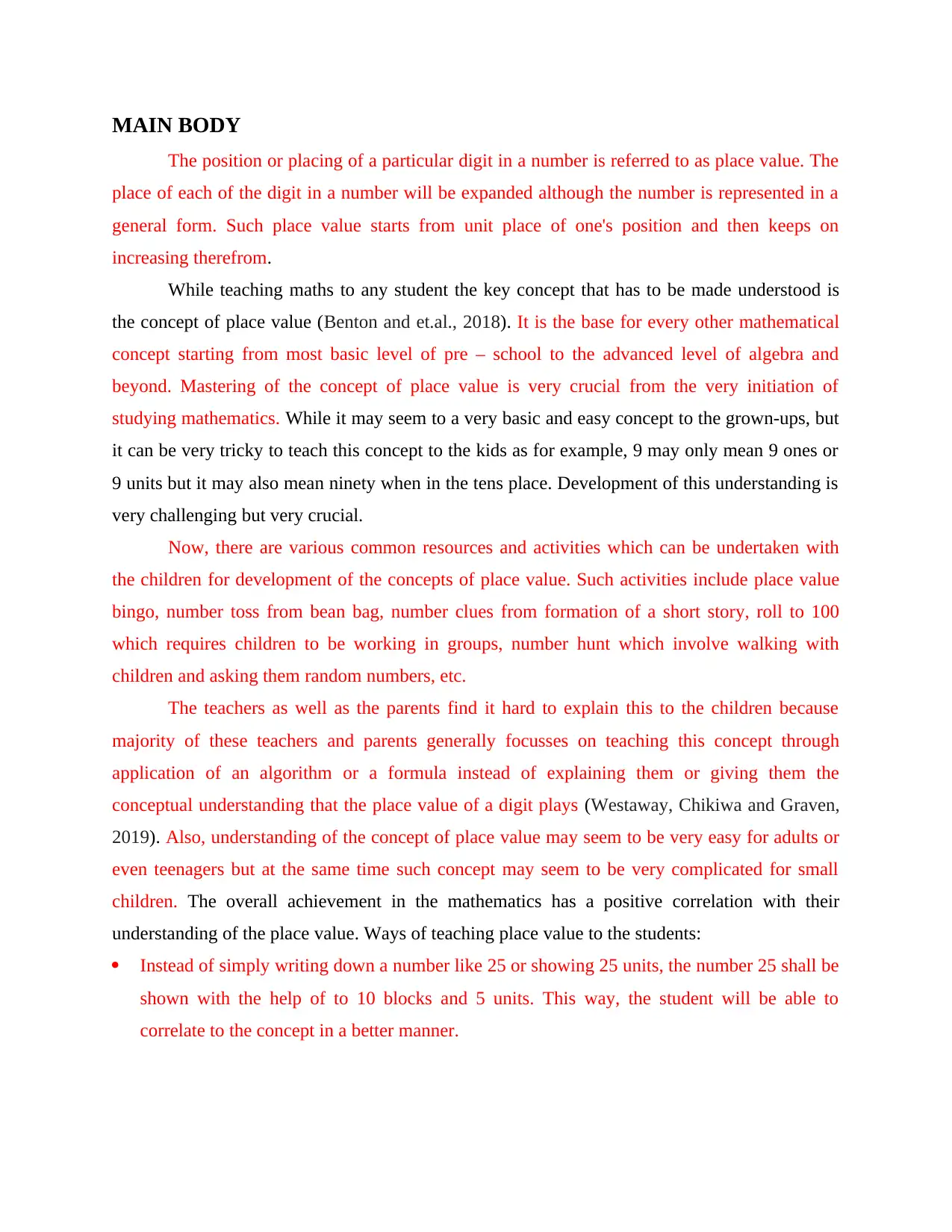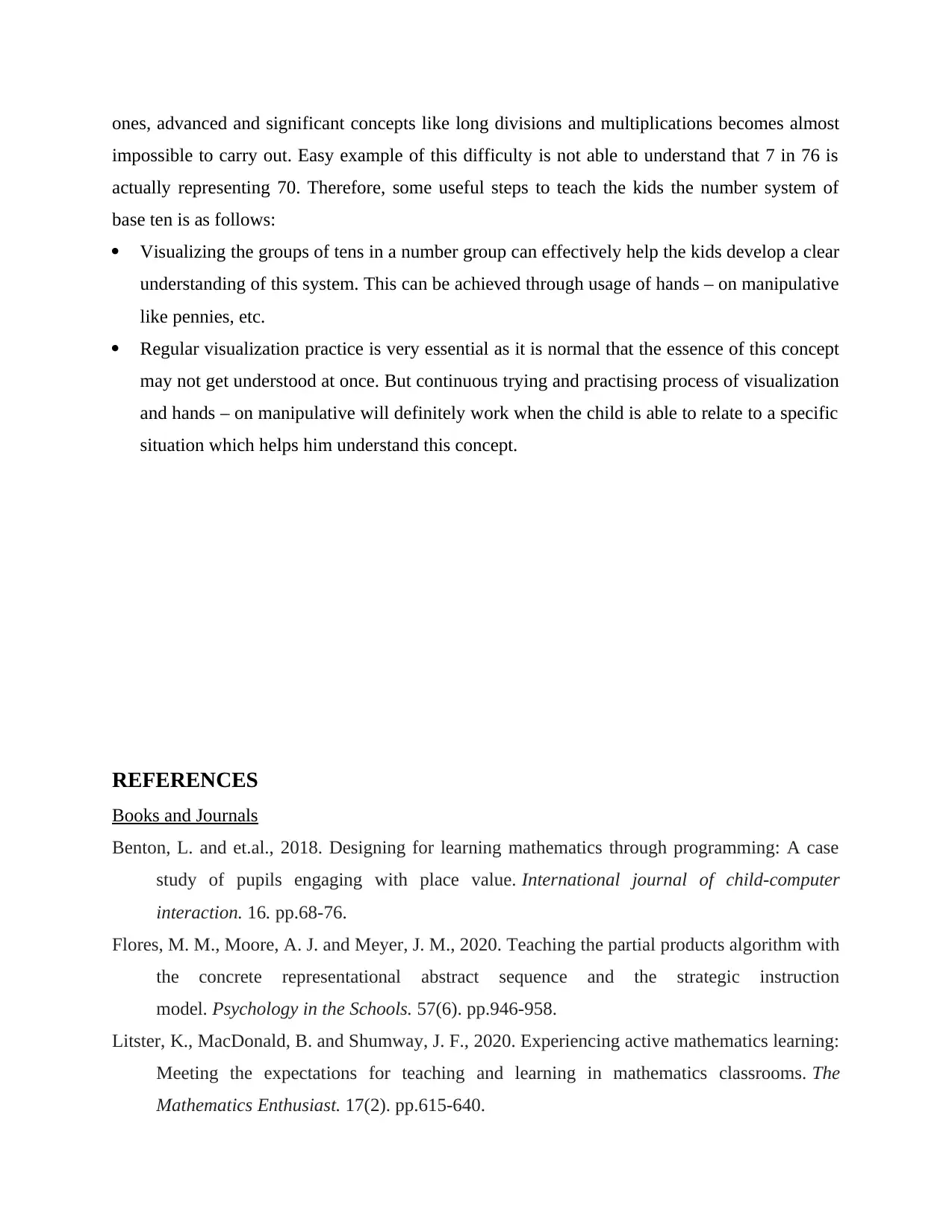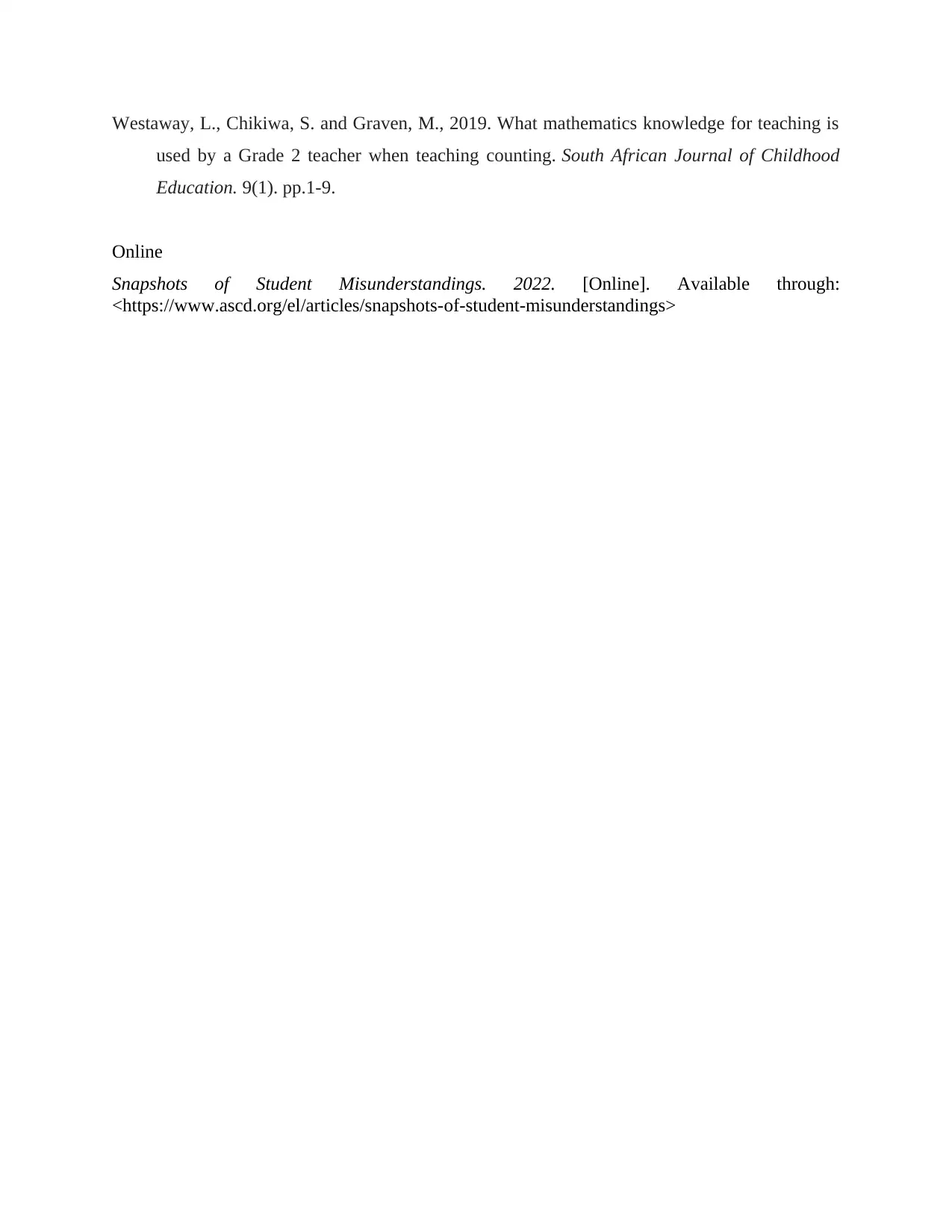Maths and Place Value: Effective Teaching Methods & Difficulties
VerifiedAdded on 2023/06/05
|6
|1298
|60
Essay
AI Summary
This essay provides a detailed overview of maths and place value, emphasizing its importance in early mathematics education. It discusses effective teaching strategies, such as using visual aids and hands-on activities, to help children understand the concept of place value. The essay also addresses common challenges and misconceptions that students face while learning place value, including difficulties with number pronunciation and performing complex calculations. Furthermore, it explains the connection between place value and the base-10 number system, highlighting the significance of understanding base-10 for grasping advanced mathematical concepts. The essay concludes by offering practical steps for teaching kids the base-10 number system, such as visualizing groups of tens and practicing regularly. Desklib provides a platform for students to access similar solved assignments and study resources to enhance their understanding of mathematical concepts.

Maths and place value
Paraphrase This Document
Need a fresh take? Get an instant paraphrase of this document with our AI Paraphraser

Table of Contents
MAIN BODY..................................................................................................................................3
REFERENCES................................................................................................................................5
MAIN BODY..................................................................................................................................3
REFERENCES................................................................................................................................5

MAIN BODY
The position or placing of a particular digit in a number is referred to as place value. The
place of each of the digit in a number will be expanded although the number is represented in a
general form. Such place value starts from unit place of one's position and then keeps on
increasing therefrom.
While teaching maths to any student the key concept that has to be made understood is
the concept of place value (Benton and et.al., 2018). It is the base for every other mathematical
concept starting from most basic level of pre – school to the advanced level of algebra and
beyond. Mastering of the concept of place value is very crucial from the very initiation of
studying mathematics. While it may seem to a very basic and easy concept to the grown-ups, but
it can be very tricky to teach this concept to the kids as for example, 9 may only mean 9 ones or
9 units but it may also mean ninety when in the tens place. Development of this understanding is
very challenging but very crucial.
Now, there are various common resources and activities which can be undertaken with
the children for development of the concepts of place value. Such activities include place value
bingo, number toss from bean bag, number clues from formation of a short story, roll to 100
which requires children to be working in groups, number hunt which involve walking with
children and asking them random numbers, etc.
The teachers as well as the parents find it hard to explain this to the children because
majority of these teachers and parents generally focusses on teaching this concept through
application of an algorithm or a formula instead of explaining them or giving them the
conceptual understanding that the place value of a digit plays (Westaway, Chikiwa and Graven,
2019). Also, understanding of the concept of place value may seem to be very easy for adults or
even teenagers but at the same time such concept may seem to be very complicated for small
children. The overall achievement in the mathematics has a positive correlation with their
understanding of the place value. Ways of teaching place value to the students:
Instead of simply writing down a number like 25 or showing 25 units, the number 25 shall be
shown with the help of to 10 blocks and 5 units. This way, the student will be able to
correlate to the concept in a better manner.
The position or placing of a particular digit in a number is referred to as place value. The
place of each of the digit in a number will be expanded although the number is represented in a
general form. Such place value starts from unit place of one's position and then keeps on
increasing therefrom.
While teaching maths to any student the key concept that has to be made understood is
the concept of place value (Benton and et.al., 2018). It is the base for every other mathematical
concept starting from most basic level of pre – school to the advanced level of algebra and
beyond. Mastering of the concept of place value is very crucial from the very initiation of
studying mathematics. While it may seem to a very basic and easy concept to the grown-ups, but
it can be very tricky to teach this concept to the kids as for example, 9 may only mean 9 ones or
9 units but it may also mean ninety when in the tens place. Development of this understanding is
very challenging but very crucial.
Now, there are various common resources and activities which can be undertaken with
the children for development of the concepts of place value. Such activities include place value
bingo, number toss from bean bag, number clues from formation of a short story, roll to 100
which requires children to be working in groups, number hunt which involve walking with
children and asking them random numbers, etc.
The teachers as well as the parents find it hard to explain this to the children because
majority of these teachers and parents generally focusses on teaching this concept through
application of an algorithm or a formula instead of explaining them or giving them the
conceptual understanding that the place value of a digit plays (Westaway, Chikiwa and Graven,
2019). Also, understanding of the concept of place value may seem to be very easy for adults or
even teenagers but at the same time such concept may seem to be very complicated for small
children. The overall achievement in the mathematics has a positive correlation with their
understanding of the place value. Ways of teaching place value to the students:
Instead of simply writing down a number like 25 or showing 25 units, the number 25 shall be
shown with the help of to 10 blocks and 5 units. This way, the student will be able to
correlate to the concept in a better manner.
⊘ This is a preview!⊘
Do you want full access?
Subscribe today to unlock all pages.

Trusted by 1+ million students worldwide

Engagement of the awareness and experience of the students multi – sensorial, they will be
able to determine the place of each digit in its proper place and also will be able to obtain
strong understanding of the basic mathematics along with better retention.
There are certain issues that the children struggle with while learning this place value concept:
Understanding the concept – Sometimes, it becomes difficult for the students to understand
the number due to the way it is pronounced in the English language i.e., eleven instead of one
ten and one. Thus, children need to learn these numbers.
Useful support – Children are most often good with the calculations which can be done on
some basis like using of the 10 fingers but when larger numbers are required to added or
subtracted, different strategies are required.
Complicacies – Performing complicated divisions which do not given an exact number and
comes in decimals, this is where students need to practice and understand the concept.
Misconceptions – Sometimes although students may give correct answers but such answers
are based on certain misconceptions which need to be corrected to avoid mistakes in more
complicated problems.
Base 10 number system is also significantly connected to the concept of place value
number system in which decimal numbers are being utilized and is used throughout the world. It
is the base for the number system of place value which is also referred as decimal system or
denary system (Litster, MacDonald and Shumway, 2020). Assignment of a position or a place to
the numbers is the method of Base 10 as the decimal point where the number is positioned shows
the numerical value of a number. In this number system, 10 is used as a base number hence the
name Base – 10 number system.
Numerical value of each digit is determined by multiplying the number 10 to the value to
its right. Therefore, number that are large than 1 will fall on the left side of the decimal and will
be called as ones, tens, hundreds, thousands, ten thousand, hundred thousand, etc. and numbers
that are smaller than 1 will fall on the right side of the decimal and will be called tenths,
hundredths, thousandths, ten thousandths, hundred thousandths, etc.
Now, it shall be noted that getting a very clear understanding of base ten is very
necessary for gaining understanding of maths (Flores, Moore and Meyer, 2020). Counting of
numbers or visualizing the numerous quantities in day to day life becomes a tedious task if a
child lacks a clear understanding of the number system of base ten. Since they will only rely on
able to determine the place of each digit in its proper place and also will be able to obtain
strong understanding of the basic mathematics along with better retention.
There are certain issues that the children struggle with while learning this place value concept:
Understanding the concept – Sometimes, it becomes difficult for the students to understand
the number due to the way it is pronounced in the English language i.e., eleven instead of one
ten and one. Thus, children need to learn these numbers.
Useful support – Children are most often good with the calculations which can be done on
some basis like using of the 10 fingers but when larger numbers are required to added or
subtracted, different strategies are required.
Complicacies – Performing complicated divisions which do not given an exact number and
comes in decimals, this is where students need to practice and understand the concept.
Misconceptions – Sometimes although students may give correct answers but such answers
are based on certain misconceptions which need to be corrected to avoid mistakes in more
complicated problems.
Base 10 number system is also significantly connected to the concept of place value
number system in which decimal numbers are being utilized and is used throughout the world. It
is the base for the number system of place value which is also referred as decimal system or
denary system (Litster, MacDonald and Shumway, 2020). Assignment of a position or a place to
the numbers is the method of Base 10 as the decimal point where the number is positioned shows
the numerical value of a number. In this number system, 10 is used as a base number hence the
name Base – 10 number system.
Numerical value of each digit is determined by multiplying the number 10 to the value to
its right. Therefore, number that are large than 1 will fall on the left side of the decimal and will
be called as ones, tens, hundreds, thousands, ten thousand, hundred thousand, etc. and numbers
that are smaller than 1 will fall on the right side of the decimal and will be called tenths,
hundredths, thousandths, ten thousandths, hundred thousandths, etc.
Now, it shall be noted that getting a very clear understanding of base ten is very
necessary for gaining understanding of maths (Flores, Moore and Meyer, 2020). Counting of
numbers or visualizing the numerous quantities in day to day life becomes a tedious task if a
child lacks a clear understanding of the number system of base ten. Since they will only rely on
Paraphrase This Document
Need a fresh take? Get an instant paraphrase of this document with our AI Paraphraser

ones, advanced and significant concepts like long divisions and multiplications becomes almost
impossible to carry out. Easy example of this difficulty is not able to understand that 7 in 76 is
actually representing 70. Therefore, some useful steps to teach the kids the number system of
base ten is as follows:
Visualizing the groups of tens in a number group can effectively help the kids develop a clear
understanding of this system. This can be achieved through usage of hands – on manipulative
like pennies, etc.
Regular visualization practice is very essential as it is normal that the essence of this concept
may not get understood at once. But continuous trying and practising process of visualization
and hands – on manipulative will definitely work when the child is able to relate to a specific
situation which helps him understand this concept.
REFERENCES
Books and Journals
Benton, L. and et.al., 2018. Designing for learning mathematics through programming: A case
study of pupils engaging with place value. International journal of child-computer
interaction. 16. pp.68-76.
Flores, M. M., Moore, A. J. and Meyer, J. M., 2020. Teaching the partial products algorithm with
the concrete representational abstract sequence and the strategic instruction
model. Psychology in the Schools. 57(6). pp.946-958.
Litster, K., MacDonald, B. and Shumway, J. F., 2020. Experiencing active mathematics learning:
Meeting the expectations for teaching and learning in mathematics classrooms. The
Mathematics Enthusiast. 17(2). pp.615-640.
impossible to carry out. Easy example of this difficulty is not able to understand that 7 in 76 is
actually representing 70. Therefore, some useful steps to teach the kids the number system of
base ten is as follows:
Visualizing the groups of tens in a number group can effectively help the kids develop a clear
understanding of this system. This can be achieved through usage of hands – on manipulative
like pennies, etc.
Regular visualization practice is very essential as it is normal that the essence of this concept
may not get understood at once. But continuous trying and practising process of visualization
and hands – on manipulative will definitely work when the child is able to relate to a specific
situation which helps him understand this concept.
REFERENCES
Books and Journals
Benton, L. and et.al., 2018. Designing for learning mathematics through programming: A case
study of pupils engaging with place value. International journal of child-computer
interaction. 16. pp.68-76.
Flores, M. M., Moore, A. J. and Meyer, J. M., 2020. Teaching the partial products algorithm with
the concrete representational abstract sequence and the strategic instruction
model. Psychology in the Schools. 57(6). pp.946-958.
Litster, K., MacDonald, B. and Shumway, J. F., 2020. Experiencing active mathematics learning:
Meeting the expectations for teaching and learning in mathematics classrooms. The
Mathematics Enthusiast. 17(2). pp.615-640.

Westaway, L., Chikiwa, S. and Graven, M., 2019. What mathematics knowledge for teaching is
used by a Grade 2 teacher when teaching counting. South African Journal of Childhood
Education. 9(1). pp.1-9.
Online
Snapshots of Student Misunderstandings. 2022. [Online]. Available through:
<https://www.ascd.org/el/articles/snapshots-of-student-misunderstandings>
used by a Grade 2 teacher when teaching counting. South African Journal of Childhood
Education. 9(1). pp.1-9.
Online
Snapshots of Student Misunderstandings. 2022. [Online]. Available through:
<https://www.ascd.org/el/articles/snapshots-of-student-misunderstandings>
⊘ This is a preview!⊘
Do you want full access?
Subscribe today to unlock all pages.

Trusted by 1+ million students worldwide
1 out of 6
Related Documents
Your All-in-One AI-Powered Toolkit for Academic Success.
+13062052269
info@desklib.com
Available 24*7 on WhatsApp / Email
![[object Object]](/_next/static/media/star-bottom.7253800d.svg)
Unlock your academic potential
Copyright © 2020–2025 A2Z Services. All Rights Reserved. Developed and managed by ZUCOL.





